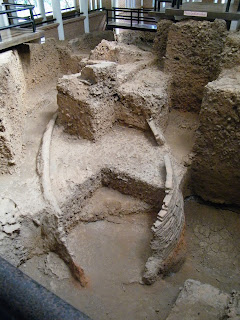 |
| Wat Chang Lom, Si Satchanalai |
 |
| The chedi of Wat Khao Suwan Khiri, and the Yom river, Si Satchanalai |
Près du Parc historique de Si Satchanalai, à 5 km se trouve un important site de fours haute température, près de 200 ont été découverts, non loin de la rivière Yom, sur une surface d'un kilomètre carré et demi. Je souhaitais voir ce site, mes photos ne peuvent donner q'une petite image de ce que j'ai vu.
Avant d'arriver au centre d'étude, à Ban Pa Yang, deux fours se faisant face sur une petite colline. Ils ont été en activité pendant environ 200/250 ans, entre le 14 ème et le 16 ème siècle. Ces fours pouvaient atteindre des températures de 1250° à 1300° Celsius.
 |
| Ban Pa Yang kiln site, Sawankhalok |
Une excavation archeologique montre des fours imbriqués les uns dans les autres, les premiers, creusés dans les rives de la Yom ont été recouverts par d'autres fours eux-même construits en brique. C'est assez étonnant et dificile de comprendre la forme. Il semble que certains avaient plusieurs chambres et plusieurs cheminées.
 |
| Ban Ko Noi kiln site |
 |
| Two chemineys, two rooms |
 |
| Shards in Sawankhalok kiln |
Partout nous avons marché sur des tessons, et sur des quilles d'enfournement qui dans certains fours étaient utilisées dans la construction de la cheminée.
 |
| Shards in Sawankhalok kiln |
A month tropical heat, deep relaxation at the edge of the sea, but also visit to Si Satchanalai Historical Park and Sawankhalok kiln site, in central Thailand on the site of the ancient kingdom of Sukhothai.
Near Si Satchanalai Historical Park, 5 km far, is an important site of high temperature kilns, nearly 200 have been discovered near the Yom River, in an area of one square kilometer and a half. I wanted to see this site my photos give a small image.
Before arriving at the study center at Ban Pa Yang, two kilns facing each other on a small hill. They have been in business for about 200/250 years, between the 14th and 16th century. These kilns can achieve temperatures of 1250 ° to 1300 ° Celsius.
Archaeological excavation shows kilns nested into each other, the first, dug into the banks of the Yom were covered by other kilns themselves built of brick. It's quite amazing and dificult to understand form. It seems that some had several rooms and several fireplaces.
Everywhere we walked on broken shards, and the pins of charging which in some kilns were used in the construction of the chimney.




2 commentaires:
Bonjour Armelle,
Lovely to see the photos of your holiday. It is good that you were able to get away to somewhere warm for part of the winter! The kilns remind me of old Viking ships, all the structure is curved like it would move easily through water! I like the first photo of the kiln, where it is surrounded by fallen leaves.
Kind thoughts from us all here, P L NS & G
Bonjour Peter,
We are really very lucky to be able to go in some warm country in the middle of the winter. I was very interested to see by myself these old kilns, anagama type kilns. Many wonderful pieces were discovered in the seabed after the sinking of ships, these ceramics were well known in Asia, Japan, Philippines in the 14th century. The leaves fall all along the year, maybe more in this dry season.
Asia is so different !!! we slept in a guesthouse in a little village there, we were the only European tourists for two nigts.
Quelle aventure :-)
Best wishes from Yves and I
Enregistrer un commentaire